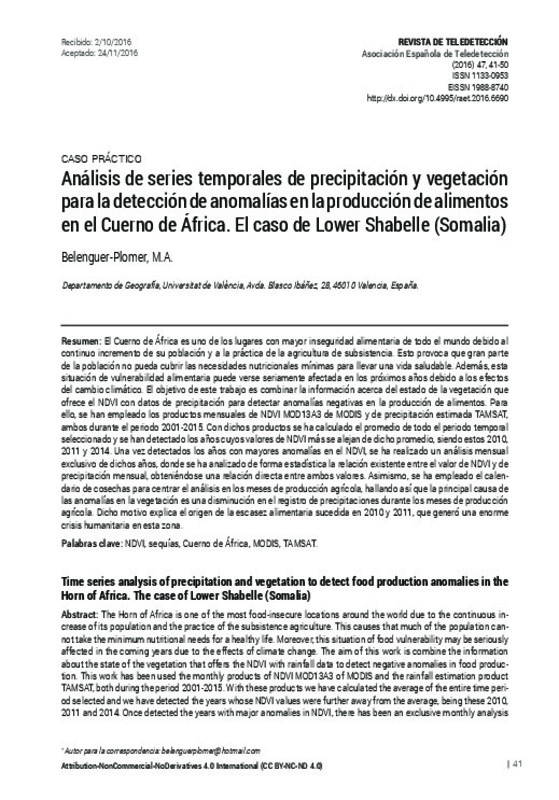JavaScript is disabled for your browser. Some features of this site may not work without it.
Buscar en RiuNet
Listar
Mi cuenta
Estadísticas
Ayuda RiuNet
Admin. UPV
Time series analysis of precipitation and vegetation to detect food production anomalies in the Horn of Africa. The case of Lower Shabelle (Somalia)
Mostrar el registro sencillo del ítem
Ficheros en el ítem
| dc.contributor.author | Belenguer-Plomer, M. A.
|
es_ES |
| dc.date.accessioned | 2017-05-02T10:09:14Z | |
| dc.date.available | 2017-05-02T10:09:14Z | |
| dc.date.issued | 2016-12-27 | |
| dc.identifier.issn | 1133-0953 | |
| dc.identifier.uri | http://hdl.handle.net/10251/80304 | |
| dc.description | Revista oficial de la Asociación Española de Teledetección | |
| dc.description.abstract | [EN] The Horn of Africa is one of the most food-insecure locations around the world due to the continuous increase of its population and the practice of the subsistence agriculture. This causes that much of the population cannot take the minimum nutritional needs for a healthy life. Moreover, this situation of food vulnerability may be seriously affected in the coming years due to the effects of climate change. The aim of this work is combine the information about the state of the vegetation that offers the NDVI with rainfall data to detect negative anomalies in food production. This work has been used the monthly products of NDVI MOD13A3 of MODIS and the rainfall estimation product TAMSAT, both during the period 2001-2015. With these products we have calculated the average of the entire time period selected and we have detected the years whose NDVI values were further away from the average, being these 2010, 2011 and 2014. Once detected the years with major anomalies in NDVI, there has been an exclusive monthly analysis of those years, where we have analysed the relationships between the value of NDVI and monthly rainfall, obtaining a direct relationship between the two values. It also has been used crop calendar to focus the analysis in the months of agricultural production and finding that the main cause of anomalies in vegetation is a decrease in the registration of rainfall during the months of agricultural production. This reason explains the origin of the food shortages that occurred in 2010 and 2011 that generated an enormous humanitarian crisis in this area. | es_ES |
| dc.description.abstract | [ES] El Cuerno de África es uno de los lugares con mayor inseguridad alimentaria de todo el mundo debido al continuo incremento de su población y a la práctica de la agricultura de subsistencia. Esto provoca que gran parte de la población no pueda cubrir las necesidades nutricionales mínimas para llevar una vida saludable. Además, esta situación de vulnerabilidad alimentaria puede verse seriamente afectada en los próximos años debido a los efectos del cambio climático. El objetivo de este trabajo es combinar la información acerca del estado de la vegetación que ofrece el NDVI con datos de precipitación para detectar anomalías negativas en la producción de alimentos. Para ello, se han empleado los productos mensuales de NDVI MOD13A3 de MODIS y de precipitación estimada TAMSAT, ambos durante el periodo 2001-2015. Con dichos productos se ha calculado el promedio de todo el periodo temporal seleccionado y se han detectado los años cuyos valores de NDVI más se alejan de dicho promedio, siendo estos 2010, 2011 y 2014. Una vez detectados los años con mayores anomalías en el NDVI, se ha realizado un análisis mensual exclusivo de dichos años, donde se ha analizado de forma estadística la relación existente entre el valor de NDVI y de precipitación mensual, obteniéndose una relación directa entre ambos valores. Asimismo, se ha empleado el calen-dario de cosechas para centrar el análisis en los meses de producción agrícola, hallando así que la principal causa de las anomalías en la vegetación es una disminución en el registro de precipitaciones durante los meses de producción agrícola. Dicho motivo explica el origen de la escasez alimentaria sucedida en 2010 y 2011, que generó una enorme crisis humanitaria en esta zona | es_ES |
| dc.language | Español | es_ES |
| dc.publisher | Universitat Politècnica de València | |
| dc.relation.ispartof | Revista de Teledetección | |
| dc.rights | Reconocimiento - No comercial - Sin obra derivada (by-nc-nd) | es_ES |
| dc.subject | NVDI | es_ES |
| dc.subject | Sequías | es_ES |
| dc.subject | Cuerno de África | es_ES |
| dc.subject | MODIS | es_ES |
| dc.subject | TAMSAT | es_ES |
| dc.subject | Drought | es_ES |
| dc.subject | Horn of Africa | es_ES |
| dc.title | Time series analysis of precipitation and vegetation to detect food production anomalies in the Horn of Africa. The case of Lower Shabelle (Somalia) | es_ES |
| dc.title.alternative | Análisis de series temporales de precipitación y vegetación para la detección de anomalías en la producción de alimentos en el Cuerno de África. El caso de Lower Shabelle (Somalia) | es_ES |
| dc.type | Artículo | es_ES |
| dc.date.updated | 2017-05-02T07:38:15Z | |
| dc.identifier.doi | 10.4995/raet.2016.6690 | |
| dc.rights.accessRights | Abierto | es_ES |
| dc.description.bibliographicCitation | Belenguer-Plomer, MA. (2016). Time series analysis of precipitation and vegetation to detect food production anomalies in the Horn of Africa. The case of Lower Shabelle (Somalia). Revista de Teledetección. (47):41-50. https://doi.org/10.4995/raet.2016.6690 | es_ES |
| dc.description.accrualMethod | SWORD | es_ES |
| dc.relation.publisherversion | https://doi.org/10.4995/raet.2016.6690 | es_ES |
| dc.description.upvformatpinicio | 41 | es_ES |
| dc.description.upvformatpfin | 50 | es_ES |
| dc.type.version | info:eu-repo/semantics/publishedVersion | es_ES |
| dc.description.issue | 47 | |
| dc.identifier.eissn | 1988-8740 |








